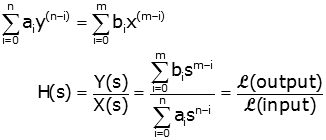
This section requires knowledge of the Laplace Transform
Contents
One of the most common and useful methods of representing a system is by its transfer function. The transfer function is easily determined once the system has been described as a single differential equation (here we discuss systems with a single input and single output (SISO), but the transfer function is easily extended to systems with multiple inputs and/or multiple outputs). Consider the differential equation with x(t) as input and y(t) as output.

To find the transfer function, first take the Laplace Transform of the differential equation (with zero initial conditions)

The transfer function is then the ratio of output to input and is often called H(s).

Note: This notation takes increasing subscripts for the an and bn coefficients as the power of s (or order of derivative decreases) while some references use decreasing subscripts with decreasing power. This notation was chosen here in part because it is consistent with MatLab's use.
The polynomial that forms the denominator of the transfer function is called the characteristic equation. We will see later that it largely determines the nature of the behavior of the system (e.g., slow or fast, oscillatory or heavily damped...). In general we will write the transfer function such that the coefficient a0 is equal to 1.
For the general case of an nth order differential equation with m derivatives of the input (superscripted numbers in parentheses indicate the order of the derivative):

This can be written in even more compact notation:

Find the transfer function of the system shown.

We have shown that the system is described by the differential equation:

Therefore the transfer function is:

The transfer function is the ratio of the Laplace transform of the output to that of the input, both taken with zero initial conditions. It is formed by taking the polynomial formed by taking the coefficients of the output differential equation (with an ith order derivative replaced by multiplication by si) and dividing by a polynomial formed in the same way from the coefficients of the input differential equation.

To reiterate: the transfer function is a "zero state" (i.e., all initial conditions are zero) representation of the system.
As stated previously, the transfer function is a common and extremely powerful method of representing a system mathematically. While the applications are not discussed here, some are enumerated below with links to other web pages that do discuss the applications.
Since the transfer function is equivalent to the other representations, there must be a way to transform from one representation to another. These methods are discussed here.